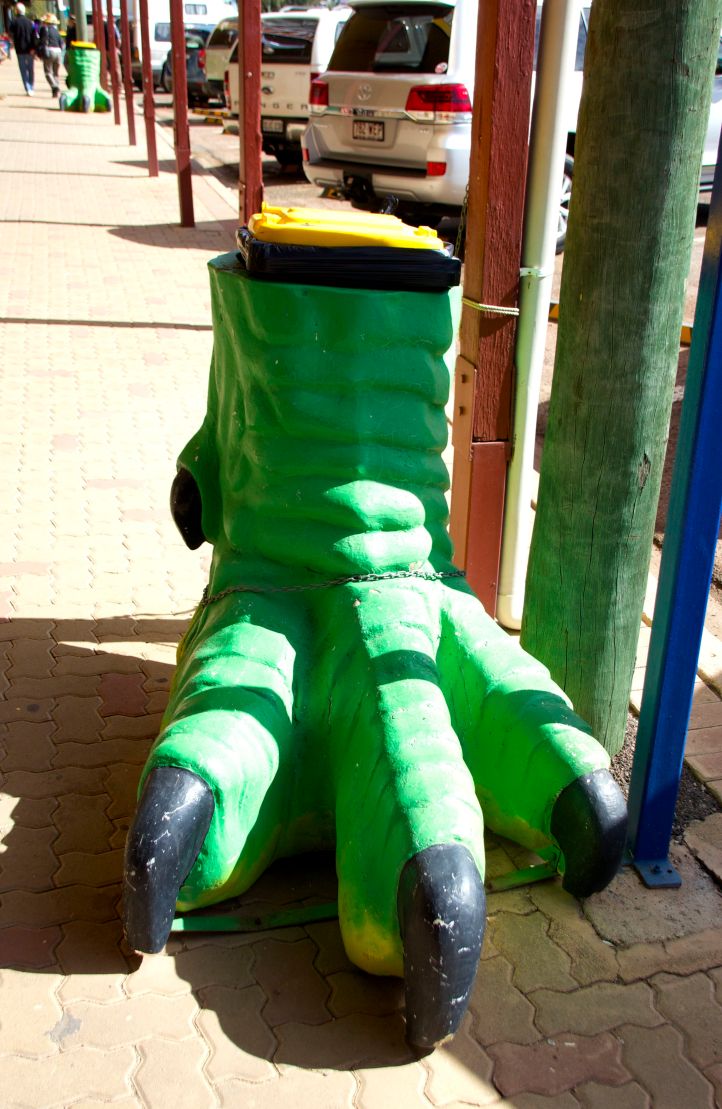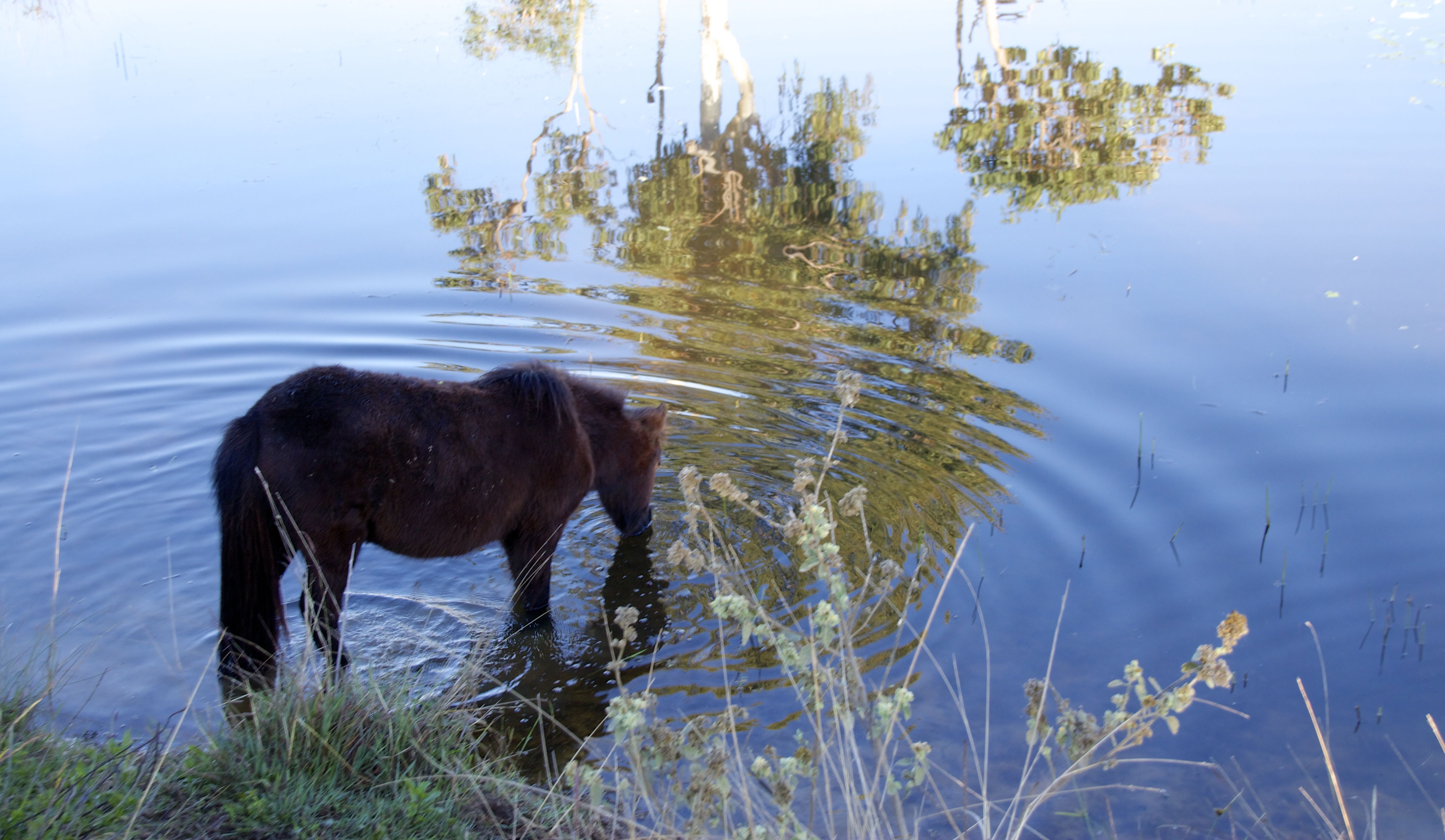We drove through Winton and out the other side to a bush camp about 5 ks out of town beside a river. It was a little on the dusty side and the locals were always making their way through the camp but we were happy with it. We were told there were blue claw in the river so we dropped our nets in.
Winton is said to be the dinosaur capital of Queensland. I like the charming way the town has let everyone know this, as the rubbish bins around the town are in the shape of dinosaur’s feet. Nice.

Before we headed off to the Dinosaur museum we took a look around the town. Winton brags to be the spot where Waltzing Matilda was first publicly sung in Australia. Waltzing Matilda is said to be one of the world’s most recorded songs and it is the unofficial national anthem of Australia.
Banjo Paterson wrote the song in January of 1895 while he was visiting friends (Bob and Christina Macpherson) at Dagworth Station. The song is filled with slang words of the time.
Waltzing Matilda – Travelling a long distance by foot.
Jumbuck – Sheep
Billabong – An area of a river, generally formed by flooding water. It is of stagnant water.
Swagman – generally a man walking from town to town looking for work.
Striking shearers had deliberately burnt down the woolshed at Dagworth station in September of 1894 as the station had employed scab labour for the shearing season. Samuel “Frenchy” Hoffmeister was said to be one of the main suspects to the crime. Three days after the burning, his body was found beside a billabong with a gunshot wound. The police reported it as being a suicide but others question that verdict.
The story inspired Banjo to write the words to the song and Christina adapted the music from a band march ‘Bonnie Wood of Craigielea’ to go with it. The song was sung at North Gregory Hotel and was an instant success, soon sweeping across the country.
Although expert disagree over, and even question what the true meaning of the words in the song are, I don’t think the common man really cares. Waltzing Matilda has been sung as a song of freedom throughout the last hundred years. Our troops took it with them when they left for the First World War and it was sung as they stormed Gallipoli and probably is still in the hearts of most of our military people even today. Does it really matter if it is an early political song or not? Not to me.
At one end of the main part of the main street of Winton is a billabong.

At the other end is a sculpture dedicated to the song. There are different blocks of concrete, each with the words of a different verse, inscribed in bronze across the top. The four sides bring to life the words written above. As you walk around the blocks you can read the words to Waltzing Matilda.
The North Gregory Hotel is not only famous for starting the legend that we now know as Waltzing Matilda but it stands proudly with it’s own history. The hotel has etchings from Daphne Mayo on its glass doors to the dining room. Daphne has been acknowledged as one of Australia’s most important artists. Probably the best known of her works were produced in the late 1920s and early 1930s. She won a travelling scholarship, which gave her the ability to study at the Royal Academy Sculpture School in London.
We walked through the hotel to look at the etchings. They were impressive. I would have liked to take some photos of the hotel itself as it is very art deco inside but there was a tour bus in having morning tea so it was a little hard to take photos with a lot of people walking around the lobby. Pity as it was charming.
North Gregory Hotel can also boast having Lyndon Johnson as a guest. Lyndon was among the passengers of the ‘Swoose’, which crash landed at Carisbrooke Station in 1942 near Winton. He then stayed at the hotel. Lyndon went on to become the 36th President of the United States of America in 1963. Australia must have been a good place to nurture Presidents for America as Herbert Hoover the 31st President of the United States spent time in Kalgoolie, Western Australia.
The North Gregory Hotel was first built in 1878. It is not the original building as that has been destroyed by fire three times. After the third fire, it looked like the hotel would not rise from the ashes again so the citizens of Winton petitioned the local shire to rebuild it. A special bill had to be passed in parliament to enable the council to own and operate the hotel. The rebuilding cost $480,000 and a special levy was added to the local rates to help raise the funds. The building took close to three years to complete. As part of the build, Daphne Mayo was asked to design three sandblasted glass etchings to be used on several of the interior doors. The doors reflect on Waltzing Matilda and Qantas. The hotel was a grand place to be with traditional bellboys, and silver service dining facilities; it added a touch of glamor to a small country town. The reopening of the hotel had a massive impact on the town. When the hotel burnt down the area was suffering a severe drought. The population of the town dropped from 3,500 to just 1,600. Opening of the pub revitalised the town. (The council sold the hotel in 1986.) I would have loved to go on a tour of the hotel to see some of the bedrooms and other rooms. It did cross my mind to pretend to be part of the bus tour hopping they may have been shown more of the hotel. I fell in love with the magic of the building.
Our walk around town took us up to Arno’s Wall. The wall is know as ‘a modern wonder of art and architecture.’ The wall contains a lot of junk, sorry, the wall contains ‘a reflection of household items and is a history of mankind.’ Over the years Arno collected a lot of junk, sorry again, items from the local town dump. Sorry, I really not doing too well with this am I? He collected items from a holding area filled with preloved items no longer required by their previous owners. He then started to add these items to his wall. The wall reaches 2 meters high and extends for about 70 meters.
The wall was interesting to look at. Most of the items were easily identified but others took some thought. There was even the kitchen sink tucked into the wall.
After the wall we walked pasted The Winton Club. The club is where the first official board meeting for Qantas was held in 1921. The people of Winton supported the new venture by buying shares in the company or gave their service for nothing. What a lovely show of support for such a new idea.
It was then time to grab the car and travel on to the swagman statue. It is dedicated to the song and to all swagmen who lie in unmarked graves throughout the country. The statue is one of Daphne’s pieces. Originally made out of fibreglass, but later was re-cast in bronze. He looked like he had lived a hard life.
Across from the Swagman statue was a wagon. It carried its last load of wool to Winton in 1936. We had seen wool wagons before but this was the first time we could climb onto one and I didn’t let the opportunity pass me by. It seemed a lot larger and higher when I was on the tray of the wagon. Wagons like this one could carry a load of 9 tons and would be drawn by 19 horses. Impressive.
We called it quits for the day and made out way to the van. We were meeting up with people we had taken over from for the farm stay in South Australia. They were also on the road like us. We had kept in contact with them. Graham was a butcher by trade and had picked up a job at the local butchers in Winton. They came out to our camp and we had a great happy hour. It was so nice to catch up with them.

























We stopped at the Blue Heeler pub (11-9-17) to be informed by a sign on the wall, Waltzing Matilda Jan.1895-First Pub Performance. This was at Kynuna. Richard Magoffin OAM was the Historian.
LikeLike
My information came from signs on the walls on the building around Winton.
LikeLike